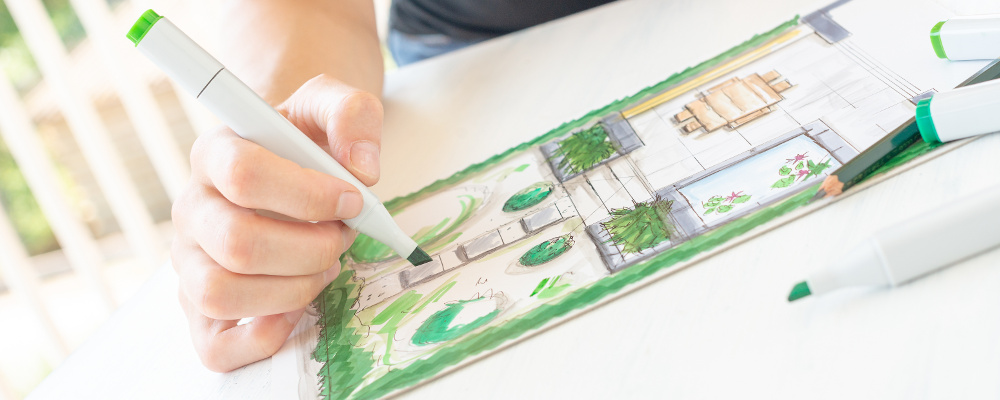
What will 2019 hold for your garden? Is it time to write a Garden Plan?
It’s that time of year when people start thinking forward and putting in place New Years’ resolutions. When it comes to your garden, a garden plan can be a great tool to help you think ahead and given that its ‘tools down-time’ for most, January is a great time to do it.
As well as giving you something to look forward to, your garden will benefit from a bit of attention and it’s good to set goals and to keep control of your garden before it starts taking control of you.
Papillon has experts to help you with this process...making the process quicker. By using our years of experience in design and construction, we can come up with ideas that are innovative.
What do you want from your garden?
So, let’s start thinking about what you want from your garden, not just in the short term, but also the long term.
To help you create a garden plan, we’ve pulled together ten steps to help:
1. Draw a plan
Start by drawing out a map or plan of your current garden to scale. Once you’ve gone through many of the points below, you can start to draw a plan of your new garden.
2. Make a list
Write a list of what you like and dislike about your garden, as well as what your aspirations are and your ‘big dreams’.
Some examples of problem areas:
- A need for more plants/vegetables/colour
- A desire for an outdoor room to enjoy the garden all seasons
- It’s not private enough
- There’s nowhere for the kids to play
- There is a damp patch in the garden
- No sitting space
- The garden is too exposed to wind, so I never get out to enjoy it
- I have a big slope in the garden (see our previous blog on what to do with a sloping garden).
- My plants aren’t growing
3. Lifestyle - how can your garden work around you?
Being aware of your lifestyle will help you work out what is realistic and what will conflict with your plan.
Some areas to consider:
- No time for gardening
- Having young kids
- A lifestyle of entertaining
- No gardening knowledge or skills
- A disability that impacts on the time spent in the garden
- No time to learn about gardening
4. What are you going to do about it?
What actions can you set to help you combat the problem areas and build your dream garden? Write them down.
5. Consider the variables
Go through your action list and consider each of the factors below – do they have an impact?
Are your actions practical solutions? Will they work in YOUR garden?
- Wind
- Sunlight
- Heavy foot traffic areas
- Shade
- Maturity height and width of plants
- Soil
- Drainage
- Views
- Access to Water
Choosing plants, as an example, can be difficult. Not every plant will take to the soil it’s planted in, so more research may be required. For damp areas, you might want to use thirsty plants to help dry out the surrounding areas. Ease of care is another factor that could influence choice. Native plants are recommended, as these will take less care and are likely to give you the best results. However, be aware as these can take over and overcome other ornamental plants.
6. Resources – people, materials, budget
People: think about the resources you have and the people you know who could lend a hand. Many of the actions will be easy enough to undertake yourself, but for some, it might be best to seek professional help and advice. Speaking to an APL accredited garden designer, such as Papillon, can help.
Materials: what materials will you use and how will you source them? Carry out your research and consider different materials for the elements they’ll be exposed to.
Budget: how much do you have to spend on your garden? This could have an impact on the materials and plants that you use, so it’s good to understand this at the outset.
7. Upcycle & recycle
If you can upcycle old goods and bring new life to them, then that is great! This will help to protect the environment and reduce emissions. Think hard about what you need for each project and have a look at some of the second-hand sales websites out there to see if you can source second-hand goods. If throwing things out, be sure to check if they are recyclable and dispose of them ethically.
8. Prioritise your list
Refine your list by highlighting the tasks that are ‘do-able’ within the next 12 months, as well as the ones that are causing problems. Tackling the real problem areas first may bring you the happiness you need to plough on. If your big problem areas are too big, then look for some ‘quick-wins’ to keep you motivated or get someone else to help.
9. Hire the right people
Ensure that your construction company have the relevant qualifications and a warranty period. A good place to look is Association of Professional Landscapers (APL).
10. Get started
Once you’ve outlined your actions and considered your resources, materials, waste, etc. it is time to get started! Do one thing at a time and don’t forget to take before and after pictures to help you see and monitor your progress.
Good luck!
For more information on garden design, please contact Papillon directly. Good luck with your garden for 2019!



